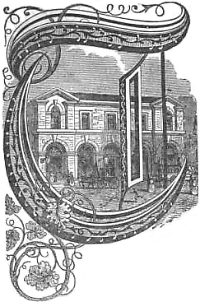 HE prodigious extent of buildings in the suburbs of London has rendered a corresponding increase
of the means of conveyance from one district to another indispensable. A few years since, Chelsea,
Brompton, Kensington, and Bayswater, forming the beautiful western suburbs of the metropolis,
were comparatively unknown to most of the inhabitants of Eastern London. Many of the parishioners
of Shadwell, Limehouse, and Poplar might have heard of the Regent's-park and Primrose-hill;
but had never visited either, for want of some direct communication brought, as it were, to
their very doors. Such a facility has just been provided by the opening of the line already
known as 'the Camden Town Railway,' which traverses the eastern and northern suburbs of the
metropolis, and enables the Londoner to take the 'overland Journey' from Fenchurch-street, City,
to Primrose-hill and the Regent's-park (the latter attractive at all seasons by its 'Zoological
Gardens'), at a very trifling expenditure of time and money. Our Artist has made the trip, pencil
and sketch-book in hand, and here are the graphic results:-
HE prodigious extent of buildings in the suburbs of London has rendered a corresponding increase
of the means of conveyance from one district to another indispensable. A few years since, Chelsea,
Brompton, Kensington, and Bayswater, forming the beautiful western suburbs of the metropolis,
were comparatively unknown to most of the inhabitants of Eastern London. Many of the parishioners
of Shadwell, Limehouse, and Poplar might have heard of the Regent's-park and Primrose-hill;
but had never visited either, for want of some direct communication brought, as it were, to
their very doors. Such a facility has just been provided by the opening of the line already
known as 'the Camden Town Railway,' which traverses the eastern and northern suburbs of the
metropolis, and enables the Londoner to take the 'overland Journey' from Fenchurch-street, City,
to Primrose-hill and the Regent's-park (the latter attractive at all seasons by its 'Zoological
Gardens'), at a very trifling expenditure of time and money. Our Artist has made the trip, pencil
and sketch-book in hand, and here are the graphic results:-
The building shown within the above initial letter is the entrance to the terminus in Fenchurch-street, where we took a sixpenny return ticket (second-class carriage), the distance from the spot where we stood, to the terminus in the Hampstead-road, being four miles and a half - the entire journey and return being, accordingly, nine miles for sixpence!
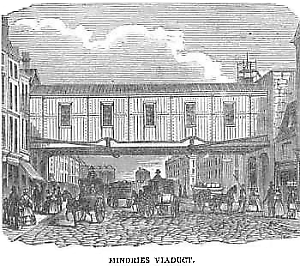 The
trains start every quarter of an hour from half-past eight in the morning till ten at night.
There was no puffing or snorting of the engine; but by a silent signal the train was set in
motion. We proceeded for a considerable distance under a covered way, lit by sash windows: this
was considered necessary at the original construction of the Blackwall Railway to prevent accidents
by horses taking fright from the noise and smoke of the engines as they dart over the bridges
crossing the streets of London. We have engraved the bridge crossing the Minories, as a specimen
of these viaducts.
The
trains start every quarter of an hour from half-past eight in the morning till ten at night.
There was no puffing or snorting of the engine; but by a silent signal the train was set in
motion. We proceeded for a considerable distance under a covered way, lit by sash windows: this
was considered necessary at the original construction of the Blackwall Railway to prevent accidents
by horses taking fright from the noise and smoke of the engines as they dart over the bridges
crossing the streets of London. We have engraved the bridge crossing the Minories, as a specimen
of these viaducts.
Through the windows we had a glimpse of the Tower of London; but soon emerged from the covered way, amid roofs of houses, an ocean of pantiles, and groves of chimneys. We passed the sugar-baking district of Goodman's-fields, the London Docks, Wapping, St. George's-in-the-East - a neighbourhood densely crowded with a busy, dingy, working or sea-going population. On the left we passed near Shadwell Church, and also St. Mary's Church and Schools, recently erected. We next arrived at Stepney Station, and began to breathe more freely, for we had left behind the region of smoke and gigantic chimneys. On the right is a new district church of the parish of Shadwell, built on the site of the house that was so marvellously preserved at the great fire of Ratcliff-cross, which broke out on the 23rd of July, 1794, and which consumed more houses than any one conflagration since the Great Fire of 1666.
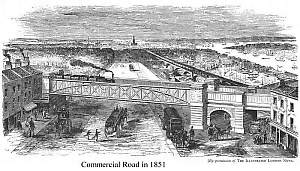 On
the left, but at some distance from the railway, is seen the square tower of Stepney Church,
the mother church of most of the parishes in the eastern part of London.
Immediately beneath us on the left is the Commercial-road, leading from Whitechapel to Blackwall,
a distance of nearly four miles. Near the junction of the Camden-town and Blackwall Railway
the Commercial-road is 80 feet in width, and is crossed by an iron viaduct, called Bow Spring
Bridge, designed by L. Clare, Esq., and constructed by Messrs. Fox and Henderson, of Birmingham.
The reader will perceived that, notwithstanding the great length of the viaduct, and the material
of which it is constructed, it has a light and picturesque appearance.
On
the left, but at some distance from the railway, is seen the square tower of Stepney Church,
the mother church of most of the parishes in the eastern part of London.
Immediately beneath us on the left is the Commercial-road, leading from Whitechapel to Blackwall,
a distance of nearly four miles. Near the junction of the Camden-town and Blackwall Railway
the Commercial-road is 80 feet in width, and is crossed by an iron viaduct, called Bow Spring
Bridge, designed by L. Clare, Esq., and constructed by Messrs. Fox and Henderson, of Birmingham.
The reader will perceived that, notwithstanding the great length of the viaduct, and the material
of which it is constructed, it has a light and picturesque appearance.
At Stepney Station the Blackwall Railroad forms a junction with the Camden-town Railroad. The former continues its course nearly parallel to the Commercial-road, by crossing a stone bridge the north side of the Regent's Canal Dock, the terminus of the Regent's-canal.
Having crossed the Commercial-road by Bow Spring Bridge, we soon leave the City and Pool of London behind us; and pass through fields to Bow-common, where to the right we have an extensive but distant view of the East India Docks; and, beyond them, a view of Surrey and Kentish Hills; on the left, the City of London and Tower Hamlets Cemetery, occupying nearly thirty acres of ground, beautifully disposed, and ornamented with cypress, cedar, and other trees, and most of the graves ornamented with flowers and shrubs. This cemetery, with an adjacent field, containing nearly one hundred and forty acres of land, is about to be purchased by the Commissioners appointed by Act of Parliament to regulate the burial-grounds of the metropolis. Beyond the cemetery is seen the extensive buildings of the City of London Union Workhouse, which from its extent and architecture has a palatial appearance.
We next descended into a deep cutting, and, passing under the Bow-road, arrived at the Bow Station. Here the train received passengers; and soon after starting we found ourselves in an open country: on the right the newly-formed Victoria Park; on the left we had an extensive view over the Hackney marshes, terminating with a considerable portion of the well-wooded scenery of Essex.
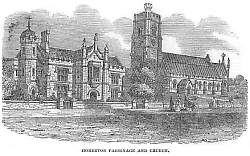 Passing
onward, through the verdant fields, we came to the retired village of Homerton, formerly
a district of the parish of Hackney, but with the last six years formed into a separate parish;
from the railroad is seen a new church, erected about four years ago, from the design of Mr.
Ashpitel.
Passing
onward, through the verdant fields, we came to the retired village of Homerton, formerly
a district of the parish of Hackney, but with the last six years formed into a separate parish;
from the railroad is seen a new church, erected about four years ago, from the design of Mr.
Ashpitel.
The church will accommodate 1800 persons, and cost less than £5000, the whole raised by subscriptions. The parsonage-house is a pleasing specimen of domestic architecture. We have now arrived at the Hackney Station: on the right, from the midst of roofs of houses and the thickly-planted trees in the churchyard and adjacent gardens, rises the picturesque tower of the old church; and to the right the pyramidal tower of the new church. Looking leftward, we were somewhat puzzled at the appearance of several long ditches, or rather trenches, filled with running water, nearly covered with what we took to be weeds; but, upon inquiry, we found this was one of the artificial streams for the continual growth of watercresses for the London market. Annexed is a representation of this singular species of cultivation, which affords a living to a great number of poor men, women, and children. The square building on the right side is the Hackney Railway Station, here the train halted for a few seconds, and then moved on towards Kingsland, which is in a deep cutting passing under the Kingsland-road.
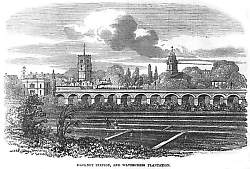 In
this district, large tracts of land, belonging to the Lord of the Manor, W. G. D. Tyssen, Esq.,
are now being laid out for building detached villas of a better class: the railway has, no doubt,
greatly accelerated the profitable occupation of this very fine estate; for, although it has
the advantage, from the nature of its soil, according to the Registrar-General's Return, of
being decidedly the most healthy locality near London, yet, until the railway brought it into
notice, and opened a communication for it, no measures taken for its improvement appear to have
been successful.
In
this district, large tracts of land, belonging to the Lord of the Manor, W. G. D. Tyssen, Esq.,
are now being laid out for building detached villas of a better class: the railway has, no doubt,
greatly accelerated the profitable occupation of this very fine estate; for, although it has
the advantage, from the nature of its soil, according to the Registrar-General's Return, of
being decidedly the most healthy locality near London, yet, until the railway brought it into
notice, and opened a communication for it, no measures taken for its improvement appear to have
been successful.
After taking up passengers at the Kingsland Station, we prodeeded through a cutting towards Islington; and, passing under the Great North-road, we arrived at the Islington and Highbury Station, at the point where the road branches to Holloway and Highbury. In constructing the railway across the road at this place it was necessary to take down a tavern, which the company have replaced by one of larger structure on the site of the old building, by erecting the same upon iron girders over the railway.
Through the high level of Islington the railway is in a cutting averaging 16 feet deep, with walls of massive brickwork to sustain the clay soil of which the district consists. We quit this cutting near the Caledonian-road and cross the same by a bridge. Within the last year the site of the Roman encampment, and for a great distance around, has been entirely covered with terraces, streets, and squares. The Model prison at Pentonville, which, when it was erected a few years back, stood in the midst of the fields, is now nearly surrounded by houses. We next passed over the Great Northern Railway; and it was a curious sight to see a monster northern train, sixty feet below us, entering the tunnel running under the extensive tract of land known as Copenhagen-fields. This is, indeed, one of the most singular views through which the railroad passes. It will be best comprehended by referring to the annexed Engraving, taken from the bridge over the Direct York Railway, at the upper end of the ancient northern road to London called Maiden-lane. From this bridge, looking down the gorge of a deep valley, we ovserve the lines of the direct York Railway gently curving to the entrance of the tunnel, which is a massive stone arch, with thick brick walls on either side, terminated by immense octangular piers formed of brick, with stone dressings. In the centre of the Great Northern Railway, a short distance from the tunnel, are two immense piers, upwards of sixty feet in height, which support the viaduct of the Camden-town Railway.
Beyond this viaduct lie Copenhagen-fields, the proposed site of the new Smithfield Market. In the centre is the tavern called Copenhagen House, where Kossuth addressed the operatives on Monday week. The large building with the lofty tower is the new prison now in the course of erection at the expense of the Corporation of the city of London.
After passing several beautiful villas, we arrived at Camden-town, where the Railway is constructed upon a brick viaduct of good proportions. The main roads are crossed by wrought iron boiler-plate bridges of the same principle as that of the celebrated tubular bridge over the Menai Straits. Some of these bridges are of considerable span, and the details of their constructing are well worthy the close examination of those who can appreciate works of this kind.
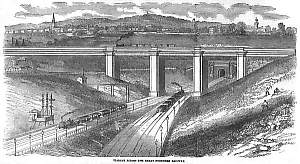 We
soon enter upon ground intersected with the rails of the Great North-Western Railway, until
we reach the end of our journey at the terminus of the Camden-town Railway, in the Hampstead-road.
We
soon enter upon ground intersected with the rails of the Great North-Western Railway, until
we reach the end of our journey at the terminus of the Camden-town Railway, in the Hampstead-road.
We started by the next train upon our return. Our fellow-passengers were journeying from this extreme north-western suburb to Margate. They accompanied us as far as the Stepney Station, where we parted - they to proceed to Blackwall, to embark in a steamer for Margate; we to return to the great city, much pleased with our economical journey, and the excellence of the accommodation afforded by the Camden-town Railway Company. We are happy to hear that their spirit and liberality are appreciated by the public, since upwards of 105,000 passengers were conveyed upon this line during the previous week.
